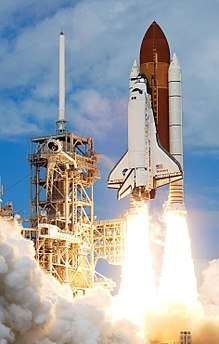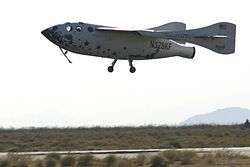Reusable launch system
A reusable launch system is a launch system that includes the recovery of some or all of the component stages. To date, several fully reusable suborbital systems and partially reusable orbital systems have been flown.

The first reusable launch vehicle to reach orbit was the Space Shuttle, which was not able to accomplish the intended goal of reducing launch costs to below those of expendable launch systems. SpaceX CEO Elon Musk has said that if one can figure out how to reuse rockets like airplanes then the cost of access to space will be reduced by as much as a factor of a hundred.[1]
During the 21st century, commercial interest in reusable launch systems has grown considerably, with several active launchers. The SpaceX's Falcon 9 rocket has a reusable first stage and capsule (for Dragon flights) and expendable second stage, The Spaceship Company has flown reusable suborbital spaceplanes, and the suborbital Blue Origin New Shepard rocket has recoverable first stages and crew capsules.
Vehicle configurations
The single stage to orbit (SSTO) approach has yet to be proven viable, while several partially reusable two stage to orbit vehicles are active or in an advanced stage of development.
Expendable rockets air launched from aircraft can be considered partially reusable if the aircraft is thought of as the first stage of the launch vehicle. An example of this configuration is the Northrop Grumman Pegasus.
The Spaceship Company combination of SpaceShipTwo and White Knight Two is a fully reusable suborbital vehicle with wings on both the launch aircraft and the rocket-propelled second stage.
Non-rocket spacelaunch systems provide a theoretical increase in efficiency.[2]
Landing
Vehicles that land horizontally on a runway require wings and undercarriage. These typically consume about 9-12% of the landing vehicle mass, which either reduces the payload or increases the size of the vehicle. Concepts such as lifting bodies offer some reduction in wing mass, as does the delta wing shape of the Space Shuttle.
Vertical landings can be accomplished either with parachutes (as with Soyuz) or propulsively. The DC-X is an example of a propulsive lander,[3] and the Falcon 9 rocket is the first orbital rocket to vertically land its first stage on the ground. This typically requires about 10% of the total first stage propellant, reducing the payload that can be carried due to the rocket equation.[4]
Reuse hardware/landing propellant
Reusable stages weigh more than equivalent expendable stages. This is unavoidable due to the supplementary systems, landing gear and/or surplus propellant needed to land a stage. The actual mass penalty depends on the vehicle and the return mode chosen.[5]
History
With the invention of rocket propulsion in the first half of the twentieth century, space travel became a technical possibility.
Early ideas of a single-stage reusable spaceplane proved unrealistic and although even the first practical rocket vehicles (V-2) could reach the fringes of space, reusable technology was too heavy. In addition many early rockets were developed to deliver weapons, making reuse impossible by design. The problem of mass efficiency was overcome by using multiple expendable stages in a vertical-launch multistage rocket. The first reusable stages did not appear until the advent of the US Space Shuttle in 1981.
Modern reusable orbital vehicles include the X-37 and the Dream Chaser.
20th century

NASA started the Space Shuttle design process in the late 1960s, with the vision of creating a fully reusable spaceplane using a crewed fly-back booster for the 1970s. This design proved too expensive and complex to develop in time, therefore the design was scaled back to use reusable solid rocket boosters and an expendable external tank.[6][7] The Shuttle proved much more expensive to operate over its 30 year lifetime than an expendable launch system would have been.
In 1986 President Ronald Reagan called for an air-breathing scramjet National Aerospace Plane (NASP)/X-30. The project failed due to severe technical issues and was canceled in 1993.[8]
In the 1990s the McDonnell Douglas Delta Clipper VTOL SSTO proposal progressed to the testing phase. The DC-X prototype demonstrated rapid turnaround time and automatic computer control.
In mid-1990, British research evolved an earlier HOTOL design into the far more promising Skylon design, which remains in development.
From the commercial side, Rocketplane Kistler and Rotary Rocket attempted to build reusable privately developed rockets before going bankrupt.
NASA proposed risky reusable concepts to replace the Shuttle technology, to be demonstrated under the X-33 and X-34 programs, which were both cancelled in the early 2000s due to rising costs and technical issues.
21st century

The Ansari X Prize contest was intended to develop private suborbital reusable vehicles. Many private companies competed, with the winner, Scaled Composites, reaching the Kármán line twice in a two-week period with their reusable SpaceShipOne.
In 2012, SpaceX started a flight test program with experimental vehicles. These subsequently led to the development of the Falcon 9 reusable rocket launcher.[9]
On 23 November 2015 the New Shepard rocket became the first Vertical Take-Off/Landing (VTOL) sub-orbital rocket to reach space by passing the Kármán line (100 km or 62 mi), reaching 329,839 ft (100,535 m) before returning for a propulsive landing.[10][3]
SpaceX achieved the first vertical soft landing of a reusable orbital rocket stage on December 21, 2015, after helping send 11 Orbcomm OG-2 commercial satellites into low Earth orbit.[11]
The first Falcon 9 second flight occurred on 30 March 2017.[12] SpaceX now routinely recovers and reuses their first stages, with the intent of reusing fairings as well.[13]
As of May 2020, the only operational reusable orbital-class launch systems are the Falcon 9 and Falcon Heavy, the latter of which is based upon the Falcon 9. SpaceX is also developing the fully reusable Starship launch system,[14] and Blue Origin is developing its own New Glenn reusable orbital rocket.
.jpg)
List of active reusable launch systems
| Company | Vehicle | Country | Type | Status | Notes |
|---|---|---|---|---|---|
| Blue Origin | New Shepard | US | Suborbital | Prototype | Under development. Will launch no earlier than 2021. |
| ISRO | RLV-TD | India | Suborbital | Project | Successful flight test[15] |
| Virgin Galactic | SpaceShipTwo | US | Suborbital | Prototype | Designed for space tourism. |
| SpaceX | Falcon 9 | US | Orbital | Operational | First stage and fairing reusable. |
| SpaceX | Falcon Heavy | US | Orbital | Operational | Core, side boosters and fairing reusable. |
References
- "Reusability". Retrieved November 20, 2019.
- Reyes, Tim (October 17, 2014). "Balloon launcher Zero2Infinity Sets Its Sights to the Stars". Universe Today. Retrieved 9 July 2015.
- Berger, Eric. "Jeff Bezos and Elon Musk spar over gravity of Blue Origin rocket landing". Ars Technica. Retrieved 25 November 2015.
- "SpaceX on Twitter". Twitter. Retrieved January 7, 2016.
- Sippel, M; Stappert, S; Bussler, L; Dumont, E (September 2017), "Systematic Assessment of Reusable First-Stage Return Options" (PDF), IAC-17-D2.4.4, 68th International Astronautical Congress, Adelaide, Australia.
- NASA-CR-195281, "Utilization of the external tanks of the space transportation system"
- "STS External Tank Station". Ntrs.nasa.gov. Archived from the original on 7 April 2015. Retrieved 7 January 2015.
- "Copper Canyon". www.astronautix.com. Retrieved 2018-06-08.
- Lindsey, Clark (2013-03-28). "SpaceX moving quickly towards fly-back first stage". NewSpace Watch. Retrieved 2013-03-29.
- "Blue Origin Makes Historic Reusable Rocket Landing in Epic Test Flight". Calla Cofield. Space.Com. 2015-11-24. Retrieved 2015-11-25.
- "SpaceX on Twitter". Twitter.
- "SpaceX successfuly launches first recycled rocket – video". Reuters. The Guardian. 31 March 2017.
- https://www.space.com/spacex-reuse-payload-fairing-starlink-launch.html
- Elon Musk (29 September 2017). Becoming a Multiplanet Species (video). 68th annual meeting of the International Astronautical Congress in Adelaide, Australia: SpaceX. Retrieved 2017-12-31 – via YouTube.CS1 maint: location (link)
- "India's Reusable Launch Vehicle-Technology Demonstrator (RLV-TD), Successfully Flight Tested - ISRO". www.isro.gov.in. Retrieved 2018-09-24.
Bibliography
- Heribert Kuczera, et al.: Reusable space transportation systems. Springer, Berlin 2011, ISBN 978-3-540-89180-2.
External links
| Wikimedia Commons has media related to Reusable manned spacecraft. |
- Illustration of a Space Shuttle at takeoff and Orbiter (Visual Dictionary - QAInternational)
